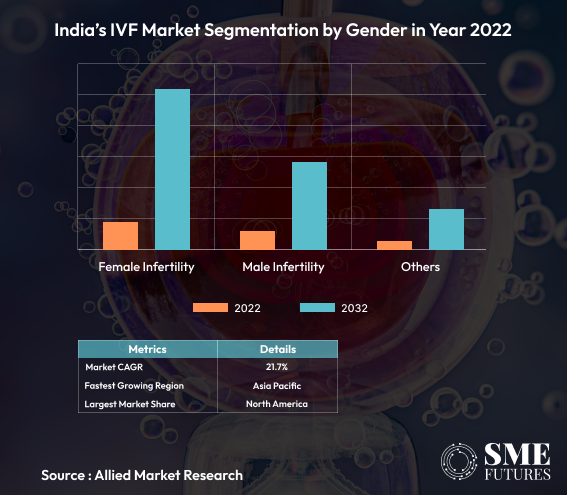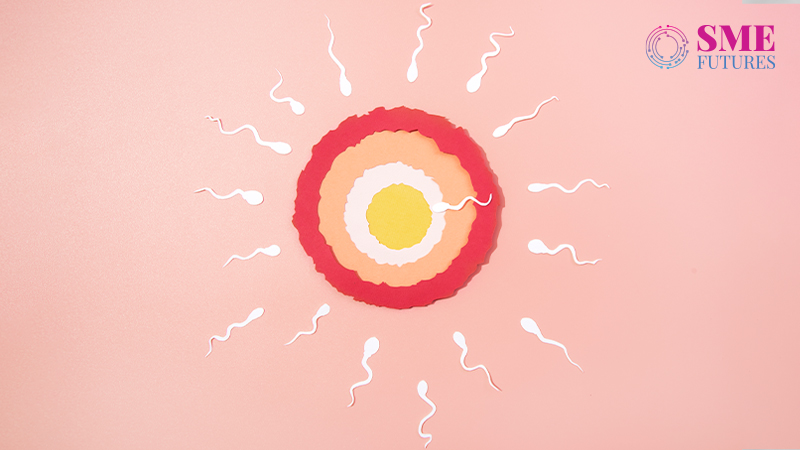As a solution to infertility, In vitro fertilisation (IVF), a kind of Assisted Reproductive Technology (ART) is gaining acceptance all around the world. The urge to have one’s own biological child has made this solution widely sought after. Cultural and societal norms of family planning, especially in South Asian countries have led couples to move from one place to another in order to seek IVF pregnancies, giving rise to IVF tourism. The best part is that genomic testing facilities prevent genetic disorders from transferring during in vitro fertilisation, which can be a reason for boosting its market globally.
The decline in Total Fertility Rate (TFR) has spurred the growth of the fertility business. Late marriages, increased age at first pregnancy, unhealthy lifestyles, and high levels of obesity, are some factors that can lead to infertility. Globally, one in every six people are struggling with infertility, according to the World Health Organization (WHO). Therefore, millions of people need fertility solutions and unsurprisingly, IVF attracts a majority of them.
“The problem of infertility has increased in recent decades and in India, almost one in fifteen couples is experiencing it. Frequent consumption of fast food, drug addiction, drinking, smoking, obesity, late marriages, lifestyle shifts, diseases and ill-health are some of the causes for this problem. However, Assisted Reproductive Technology (ART) such as in vitro fertilisation has come up as a hope for infertile patients. Every year, around 5 to 10% infertile couples invest in such treatments.” Says well-known infertility specialist Dr Rajni Tiwari, Director and Consultant at Dr Rajni’s Matritva Women’s Healthcare & IVF Centre, Azamgarh.
On-going expansion of IVF market
According to a recent analysis by Grand View Research, the IVF industry is predicted to increase at a 5.54 per cent CAGR between 2024 and 2030. In India, the IVF industry exceeded $750 million in 2020 and is predicted to reach $4 billion by 2030. Demand for this treatment is not limited to metropolitan cities but also extends to rural areas. Villages in India are progressing in terms of access to medical facilities, education and transport. Therefore, advanced treatments for fertility have paved the way for rural people to find ideal fertility solutions, expanding the reach of the IVF market.
Dr Tiwari highlights the increasing popularity of IVF in urban as well as rural India, saying, “Because of more awareness nowadays, the rural population is also contributing to the IVF market. In the last two years, I have come across patients who belong to villages and have requested fertility solutions from me. During COVID-19, the fertility treatments were shut down but now, there is a rapid rise in the number of people seeking such treatments. There is also a visible increase in the establishment of more fertility centres in small and big cities and towns.”
According to Dr Priyanka, Fertility Consultant at Sonakshi IVF Center, Rohtak, Haryana, “IVF is not just a medical procedure, it is a journey of hope, perseverance and the profound desire to nurture life. Witnessing the joy on a patient’s face after successful IVF treatment is one of the rewarding experiences in medicine. Couples investing in IVF are actually investing in their happiness.”
Both male and female infertility can cause childlessness. However, in India, the IVF market is dominated by female infertility. Women who wish to conceive are more likely to choose IVF treatment in the country.

High expenditure on IVF
Another fact associated with Assisted Reproductive Technology like in vitro fertilisation is that it is not affordable for everybody. It is expensive and only those with high incomes can avail themselves of these treatments. They might belong to rural or urban areas, but they must be ready to invest in the fertility market throughout the treatment.
Such treatments involve longer time durations, patience and complex procedures. Multiple consultations and check-ups, diagnostics, hormonal therapies, retrieval of eggs, embryo culture and transfer are some vital procedures that might cost around Rs 2 lakhs in three to five weeks. An average Indian couple who struggles to meet day to day expenses cannot afford this easily. So, ART therapy is still confined to high-net-worth individuals.
According to Kiran Gadela, Co-Founder and Managing Director of Oasis Fertility, Hyderabad, the cost of treatment in India ranges from $1500-2500, making it one of the most affordable countries in terms of treatments. “My estimate is that the IVF segment as a sector is going to grow at a CAGR of 20-25% YoY in terms of catering to the Indian population.” he quotes in an interview with ET Healthworld.
At the same time, IVF is expensive because every procedure involved in it requires highly skilled and knowledgeable professionals. Like, from Anesthesia point of view, highlights Dr Syed Irfan Ahmed, Consultant Anesthesiologist and Critical Care Specialist at Women Hospital in Azamgarh.
“Sedation is a common type of Anesthesia used during egg retrieval. It is a combination of different medicines that will help the patient to relax (sedative), and then pian would be blocked (anesthetic). If conscious sedation is done, then it helps the patient to recover soon.”
Due to the increase in the number of ART specialists and centres in India, it has become an ideal destination for IVF tourism. People from around the world visit India every year to fulfil their dreams of parenthood. Also, the cost of IVF treatment in India is lower than it is in developed nations.
With the urge to conceive and have one’s own child, people who can afford it, do not mind visiting different countries to get the best possible solutions. This boosts both the medical sector and the travel and tourism sector.
Also, considering many single women’s urge to become mothers, the Assisted Reproductive Technology (Regulation) Bill, 2021 came into effect in January 2023. It says that any single woman above 21 years of age can choose IVF to become a single mother.
IVF for surrogacy
IVF for surrogacy has also contributed to medical tourism, in which people from different countries travel to other countries to get their baby implanted in the womb of a surrogate mother. In case of commercial surrogacy, the surrogate mother is paid a huge sum for offering her womb for a couple’s child. People who get their sperm or eggs preserved for later are more likely to choose surrogacy.
India has however now banned commercial surrogacy and allows altruistic surrogacy depending upon the case. Countries like Mexico, Ukraine, Israel and a few others allow foreign parents for commercial surrogacy. Most countries including India, Canada, Greece, and The United States of America allow altruistic surrogacy in which, the surrogate mother willingly carries the couple’s child in her womb without any financial compensation.
With time, IVF devices and techniques have become more advanced and convenient. Artificial Intelligence (AI) has revolutionised the medical sector and ART has come under its ambit too. According to a study by DataM Intelligence, the market size of IVF devices and consumables was up to $2.147 million in 2021 and is now growing at a 21.7 per cent CAGR for the 2023-2030 period. With the increasing demand for infertility treatments, in vitro fertilisation has created a niche for itself in the healthcare arena. Ultimately, due to the vision of knowledgeable and skilled specialists and the development of well-equipped centres and new techniques, the IVF market is poised for exponential growth in the coming years, creating a ray of hope for childless people.











